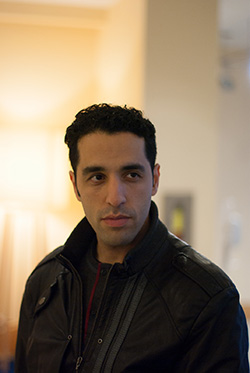Well-Located on the Map: John Barton in Conversation with Mehdi M. Kashani

In "Dayi," which appears in The Malahat Review’s Spring 2017 issue, Mehdi M. Kashani tells the story of Parveez, a businessman who, while packing to leave Iran in order to join his wife and children in Vancouver, spends his last evening in Tehran with Shireen, a young woman his daughter’s age with whom he’s been having an affair.
One of Mehdi M. Kashani's short stories in Persian won first place in the Sadeq Hedayat 12th Annual Short Story Contest in 2014. His fiction has appeared in Hobart and Litro and is forthcoming in the Los Angeles Review and the Portland Review. He lives and writes in Toronto.
It was (and remains) a delight to read "Dayi" and to gain some insight into the life led in Tehran by men and women like Parveez and Shireen, who live there. As a westerner reading about Parveez's infidelity, I find myself forming a very different impression of the Islamic Republic of Iran than I do from the sometimes alarmist headlines in and on Canadian, American, and European newspapers and news sites. What motivated you to write "Dayi" and do you see readers like me as a key part of its audience? What strikes you about the way readers like me approach and interpret your stories about Iran?
Thanks John. I'm glad to hear "Dayi" hits the right note.
Last year, a friend of mine shared a link about Iranian university students who use a controversial, online service to find sugar daddies to pay off their student loans. The girl profiled in the article, a law-school graduate, had the same last name as me. My friend wanted to know if we were related. It was funny at the time, but a few days later I began remembering similar "unofficial" cases I knew were happening in Iran, though none involved a man with his family living abroad. I also had heard about relationships turning cold because of the same long-distance setup as in the story. So all I had to do was to combine the two threads into one coherent narrative.
With regards to the clichéd portrayal of contemporary Iran in Western media, Iranians in the diaspora have talked so much against it that, ironically, our denial seems to have turned into another cliché! Iran is truly a country of contradictions, where men and women are not allowed to touch each other in public, yet more and more young couples live together without being married, to an extent that the establishment has grudgingly admitted to this "predicament" and even has a name for it: "White Marriage." Iran is in transition and, in many cases, it's changing without proper guidance. So, things that happen in Iran at times are more radical than here in the West. It is the 60's redux. I hear of boys and girls having multiple partners at the same time while in the West the general impression is that Iranians, while unmarried, don't even have one partner. Infidelity abounds. And, of course, divorce, which used to be a taboo, has become very commonplace, too.
Parveez is a man split between two countries and two very different societies: Canada, where his wife and children have been living for several years and Iran, where he has status as a business man and entrepreneur, but is estranged from the warmth of family life. What motivates men like Parveez to decide such a compartmentalized life?
Unfortunately, the scenario you describe is a very common phenomenon in modern Iran. Many affluent families in Tehran and some of the other big cities will, given the chance, apply to immigrate to countries like Canada and Australia. That doesn't mean they necessarily intend to immigrate the moment they fill out the forms, but they want to keep that option open. When you live in a country that is always under the constant threat of war and economical sanction, this is not surprising. Then, when the time comes that their immigration application is approved (usually several years later), they need to make a decision and that's when people like Parveez have to choose to stay or leave. For older men (and women) his age, it's fiercely hard to start a business in a new country. Many of them can't properly speak English. They know enough to get by—but that won't do. On the other hand, their children enjoy living abroad for obvious reasons: better education, more freedoms, etc. So people like Parveez spend much of their time working in Iran to fund the cost of immigration, literally and metaphorically.
What do you think motivates a girl like Shireen to attach herself to a man like Parveez? What social circumstances in Iran influenced the direction her life took when she first offered to model the dress that Parveez had initially thought of as a gift for his daughter, Mahsa?
Another phenomenon in contemporary Iran is an increasing materialistic view among younger generations. The Iran I left thirteen years ago was much different than it is now. Iranian values are constantly changing. Whenever I travel to Tehran, I'm amazed by the number of the latest iPhones I see in people's hands, some of whom, I suppose, had to borrow to afford the luxury. Or, the number of Porsches or Maseratis on the streets. Combine that with the recent trend in women's sense of individualism (another imported concept, yet to be fully absorbed to the culture) and you encounter young pretty women like Shireen, a student who is not a bad person by nature but finds hereself caught in the middle of a futile and phony rat-race. You can also read Freudian themes into her relationship with Parveez, but that wasn't what I had in mind as I wrote this story. That theme is already extensively explored in Western literature.
Shireen, Parveez's "bed companion" in Tehran and Mahsa, his daughter in Vancouver, are close in age, a fact that becomes more significant to Parveez upon learning with discomfort that Mahsa is dating a Serbian man in his 40s. Shireen and Mahsa seem to be foils for, or opposites of, one another. What do you hope readers will think about when encountering the differences and similarities between the two young women's lives?
Parveez needed some sort of provocation, a trigger if you will, to pull him out of his misperception (or reverie). I tried to achieve that by drawing parallels between the two women. But to answer your question: Shireen and Mahsa are both risk-takers. For a woman just arriving from Iran, it is unusual enough to date a non-Iranian, let alone a man in his forties. And Shireen is also taking a risk "dating" Parveez, especially if she has a younger boyfriend as well (I intentionally left this vague in the story). To me, these two women are both practical people that, for better or worse, act on their thoughts.
In one of the many witty and/or ironic passages throughout "Dayi," you describe Canada as "the second 'widest' country in the world [that] had pulled wife and husband apart." Of course, Canadians are conditioned into thinking of it as the "second 'largest.'" The "girth" of Canada implied by "widest" versus the "size" of Canada implied by "largest" points to differences in the ways in which "Canadians" view ourselves in comparison to how "immigrants" or "new" Canadians see the country to which they have come. How do you think such subtle, even dissonant, differences in perception are influencing Parveez as he prepares to leave Tehran permanently for Vancouver?
Well, the short answer is that I needed the "wideness" for that sentence to work. It is talking about two people drifting apart and it makes sense only when what comes in between is "wide" as opposed to "large." I couldn't have written that line had they immigrated to Chile. Also, in my experience, immigrants are obsessed with the concept of distance. They're concerned about flight hours or time zones. It's as if the farther they are from their homeland, the deeper they feel uprooted. In that sense, a country like Canada, is a bit intimidating, when flying from Halifax to Vancouver can take eight hours.
Am I correct in thinking that you wrote "Dayi" in English? If so, can you articulate the differences you may have experienced in writing English and writing in Farsi? When writing in either language do you find yourself constructing your stories differently (the depth of detail required to provide sufficient context, for example), knowing that the worldviews of their intended readers could potentially vary so greatly?
Actually, "Dayi" was the last story I wrote in Farsi. For a while, I wrote in both languages. Then, I stopped writing in Farsi (a decision I've adhered to for about a year). So, I rewrote it in English. Turning a story from one language to another, gives me a chance to revise as I go. It's not a pure translation; I don't have to stay faithful to the original because I'm the writer.
Regardless, when I write for the non-Iranian audience, I try to simplify things if they don't drive the story forward. As an example, there is an Islamic concept called nazr. When you say (literal translation), "I've made a nazr to Imam Reza for my son to get admitted to Harvard," you're saying that you've made an offer to the Shi'ite saint, Reza, that you'll donate to a charity if he helps your son to get admitted to Harvard. While it's a very prevalent practice among religious families in Iran, it could be hard to explain within the confines of a short story. It might distract the reader away from the plot. So, in the story, I'd replace that with something like, "I prayed for my son", unless there's some reason against it, narrative-wise (e.g., the protagonist made the nazr at Imam Reza's Shrine).
That being said, sometimes it helps or even energizes the story to introduce unfamiliar concepts or words. I had this in mind when I chose the title for Dayi. I thought it could be interesting for non-Iranian readers to know there's a language in the world, in which, there are two words for uncle, depending on whether he's paternal or maternal. I could have named the story "Uncle." But, I hope, Dayi lends a magical quality, while at the same time, locates the story in a country on the map.

John Barton
* * * * * * * *









